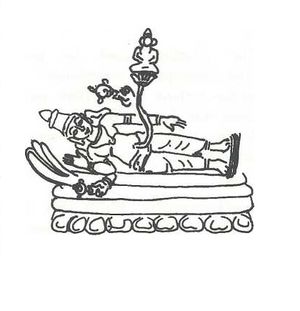Rañganātha
By Swami Harshananda
Rañganātha, along with Varadarāja of Kāñcīpuram and Veṅkaṭeśa of Tirupati, is the most popular aspect of Viṣṇu worshiped in South India. The well-known temple at Śrīraṅgam in Tamil Nadu is the very heart of the Śrīvaiṣṇava sect. The original icon of this temple is said to have been born out of the ocean and given by Śrī Rāma to Vibhīṣaṇa. While carrying it from Ayodhyā to Laṅkā, Vibhīṣaṇa placed it on the ground at the present site, in order to rest a while. Unfortunately for him and fortunately for others it got firmly fixed there.
The image is of the Yogaśayana type[1] with only two hands, the right hand apparently supporting the head while the left rests on the serpent-bed. The lotus with Brahmā, the Āyudha-puruṣas,[2] the demons Madhu and Kaiṭabha who were killed by him and some sages like Bhṛgu and Mārkaṇḍeya are often depicted along with the image of Lord. Similar Yogaśayana images are found in Śrīraṅgapaṭna of Karnataka and Tiruvanantapuram of Kerala where it is known as Padmanābha or Anantaśayana.
References[edit]
- The Concise Encyclopedia of Hinduism, Swami Harshananda, Ram Krishna Math, Bangalore

